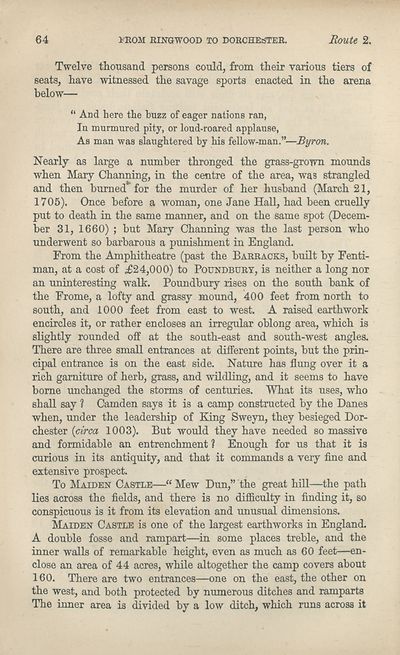Download files
Complete book:
Individual page:
Thumbnail gallery: Grid view | List view

64
D'ROM RING WOOD TO DORCHESTER.
Route 2.
Twelve thousand persons could, from their various tiers of
seats, have witnessed the savage sports enacted in the arena
below—
“ And here the buzz of eager nations ran,
In murmured pity, or loud-roared applause,
As man was slaughtered by his fellow-man.”—Byron.
Nearly as large a number thronged the grass-grown mounds
when Mary Channing, in the centre of the area, was strangled
and then burned4* for the murder of her husband (March 21,
1705). Once before a woman, one Jane Hall, had been cruelly
put to death in the same manner, and on the same spot (Decem¬
ber 31, 1660) ; but Mary Channing was the last person who
underwent so barbarous a punishment in England.
From the Amphitheatre (past the Barracks, built by Fenti-
man, at a cost of ,£24,000) to Poundburt, is neither a long nor
an uninteresting walk. Poundbury rises on the south bank of
the Frome, a lofty and grassy mound, 400 feet from north to
south, and 1000 feet from east to west. A raised earthwork
encircles it, or rather encloses an irregular oblong area, which is
slightly rounded off at the south-east and south-west angles.
There are three small entrances at different points, but the prin¬
cipal entrance is on the east side. Nature has flung over it a
rich garniture of herb, grass, and wildling, and it seems to have
borne unchanged the storms of centuries. What its uses, who
shall say ? Camden says it is a camp constructed by the Danes
when, under the leadership of King Sweyn, they besieged Dor¬
chester (circa 1003). But would they have needed so massive
and formidable an entrenchment ? Enough for us that it is
curious in its antiquity, and that it commands a very fine and
extensive prospect.
To Maiden Castle—“ Mew Dun,” the great hill—the path
lies across the fields, and there is no difficulty in finding it, so
conspicuous is it from its elevation and unusual dimensions.
Maiden Castle is one of the largest earthworks in England.
A double fosse and rampart—in some places treble, and the
inner walls of remarkable height, even as much as 60 feet—en¬
close an area of 44 acres, while altogether the camp covers about
160. There are two entrances—one on the east, the other on
the west, and both protected by numerous ditches and ramparts
The inner area is divided by a low ditch, which runs across it
D'ROM RING WOOD TO DORCHESTER.
Route 2.
Twelve thousand persons could, from their various tiers of
seats, have witnessed the savage sports enacted in the arena
below—
“ And here the buzz of eager nations ran,
In murmured pity, or loud-roared applause,
As man was slaughtered by his fellow-man.”—Byron.
Nearly as large a number thronged the grass-grown mounds
when Mary Channing, in the centre of the area, was strangled
and then burned4* for the murder of her husband (March 21,
1705). Once before a woman, one Jane Hall, had been cruelly
put to death in the same manner, and on the same spot (Decem¬
ber 31, 1660) ; but Mary Channing was the last person who
underwent so barbarous a punishment in England.
From the Amphitheatre (past the Barracks, built by Fenti-
man, at a cost of ,£24,000) to Poundburt, is neither a long nor
an uninteresting walk. Poundbury rises on the south bank of
the Frome, a lofty and grassy mound, 400 feet from north to
south, and 1000 feet from east to west. A raised earthwork
encircles it, or rather encloses an irregular oblong area, which is
slightly rounded off at the south-east and south-west angles.
There are three small entrances at different points, but the prin¬
cipal entrance is on the east side. Nature has flung over it a
rich garniture of herb, grass, and wildling, and it seems to have
borne unchanged the storms of centuries. What its uses, who
shall say ? Camden says it is a camp constructed by the Danes
when, under the leadership of King Sweyn, they besieged Dor¬
chester (circa 1003). But would they have needed so massive
and formidable an entrenchment ? Enough for us that it is
curious in its antiquity, and that it commands a very fine and
extensive prospect.
To Maiden Castle—“ Mew Dun,” the great hill—the path
lies across the fields, and there is no difficulty in finding it, so
conspicuous is it from its elevation and unusual dimensions.
Maiden Castle is one of the largest earthworks in England.
A double fosse and rampart—in some places treble, and the
inner walls of remarkable height, even as much as 60 feet—en¬
close an area of 44 acres, while altogether the camp covers about
160. There are two entrances—one on the east, the other on
the west, and both protected by numerous ditches and ramparts
The inner area is divided by a low ditch, which runs across it
Set display mode to:
![]() Universal Viewer |
Universal Viewer | ![]() Mirador |
Large image | Transcription
Mirador |
Large image | Transcription
| Antiquarian books of Scotland > Adventure and adventurers > Black's guide to Dorsetshire > (80) |
|---|
| Permanent URL | https://digital.nls.uk/116814872 |
|---|
| Description | Thousands of printed books from the Antiquarian Books of Scotland collection which dates from 1641 to the 1980s. The collection consists of 14,800 books which were published in Scotland or have a Scottish connection, e.g. through the author, printer or owner. Subjects covered include sport, education, diseases, adventure, occupations, Jacobites, politics and religion. Among the 29 languages represented are English, Gaelic, Italian, French, Russian and Swedish. |
|---|

